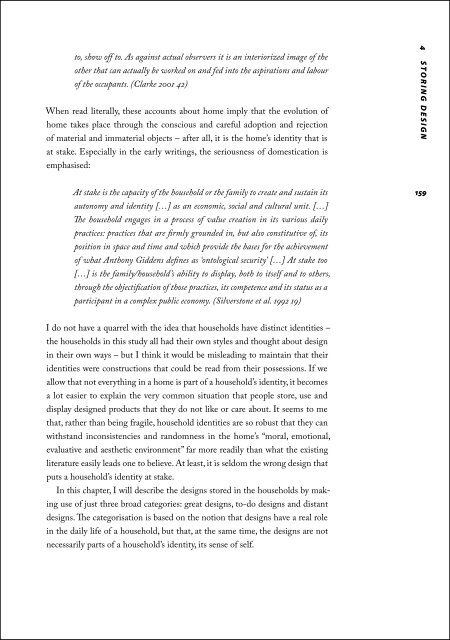Lataa ilmaiseksi
Lataa ilmaiseksi
Lataa ilmaiseksi
You also want an ePaper? Increase the reach of your titles
YUMPU automatically turns print PDFs into web optimized ePapers that Google loves.
to, show off to. As against actual observers it is an interiorized image of the<br />
other that can actually be worked on and fed into the aspirations and labour<br />
of the occupants. (Clarke 2001 42)<br />
When read literally, these accounts about home imply that the evolution of<br />
home takes place through the conscious and careful adoption and rejection<br />
of material and immaterial objects – after all, it is the home’s identity that is<br />
at stake. Especially in the early writings, the seriousness of domestication is<br />
emphasised:<br />
4 S T O R I N G D E S I G N<br />
At stake is the capacity of the household or the family to create and sustain its<br />
autonomy and identity […] as an economic, social and cultural unit. […]<br />
The household engages in a process of value creation in its various daily<br />
practices: practices that are firmly grounded in, but also constitutive of, its<br />
position in space and time and which provide the bases for the achievement<br />
of what Anthony Giddens defines as ‘ontological security’ […] At stake too<br />
[…] is the family/household’s ability to display, both to itself and to others,<br />
through the objectification of those practices, its competence and its status as a<br />
participant in a complex public economy. (Silverstone et al. 1992 19)<br />
159<br />
I do not have a quarrel with the idea that households have distinct identities –<br />
the households in this study all had their own styles and thought about design<br />
in their own ways – but I think it would be misleading to maintain that their<br />
identities were constructions that could be read from their possessions. If we<br />
allow that not everything in a home is part of a household’s identity, it becomes<br />
a lot easier to explain the very common situation that people store, use and<br />
display designed products that they do not like or care about. It seems to me<br />
that, rather than being fragile, household identities are so robust that they can<br />
withstand inconsistencies and randomness in the home’s “moral, emotional,<br />
evaluative and aesthetic environment” far more readily than what the existing<br />
literature easily leads one to believe. At least, it is seldom the wrong design that<br />
puts a household’s identity at stake.<br />
In this chapter, I will describe the designs stored in the households by making<br />
use of just three broad categories: great designs, to-do designs and distant<br />
designs. The categorisation is based on the notion that designs have a real role<br />
in the daily life of a household, but that, at the same time, the designs are not<br />
necessarily parts of a household’s identity, its sense of self.
















